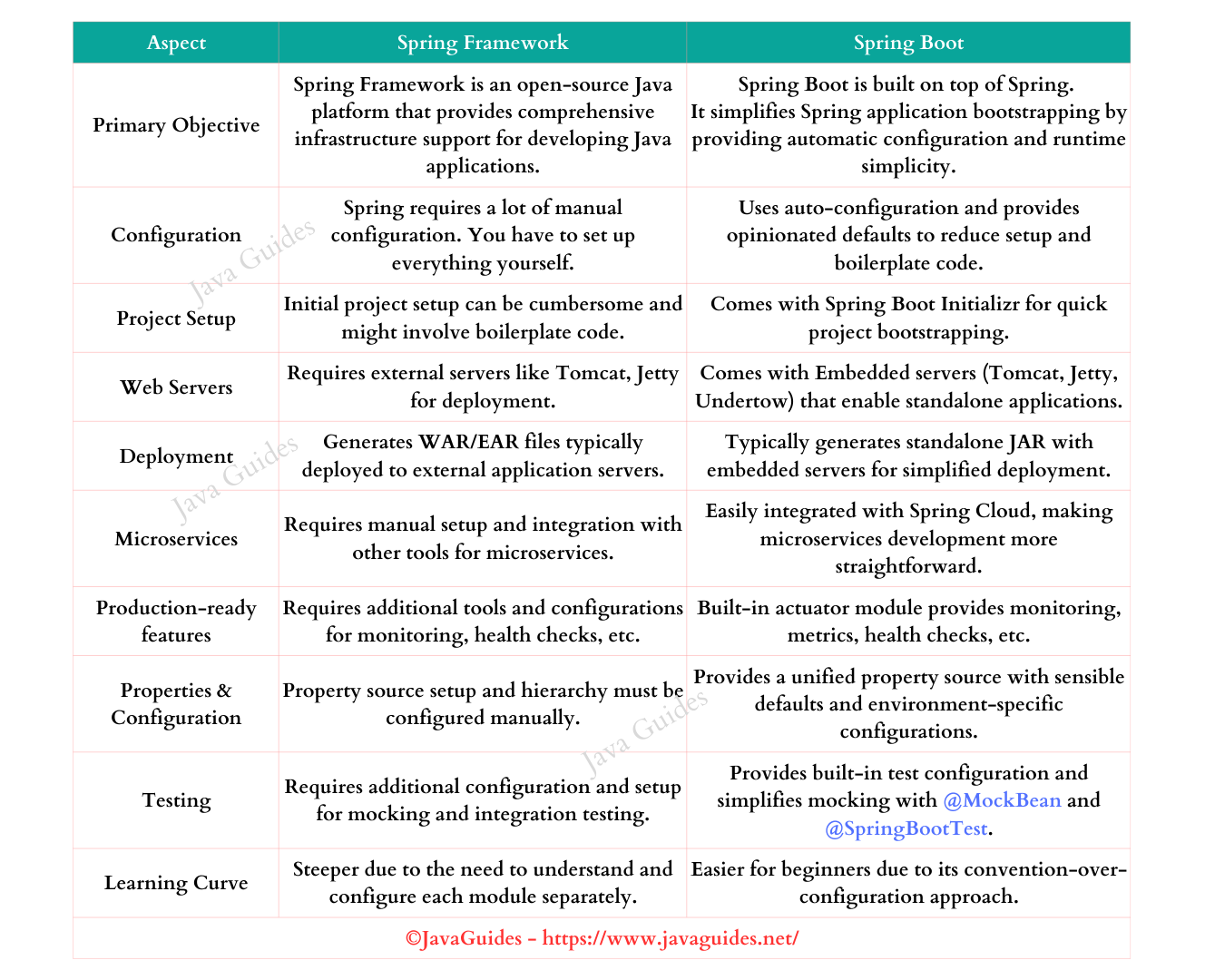🎓 Top 15 Udemy Courses (80-90% Discount): My Udemy Courses - Ramesh Fadatare — All my Udemy courses are real-time and project oriented courses.
▶️ Subscribe to My YouTube Channel (178K+ subscribers): Java Guides on YouTube
▶️ For AI, ChatGPT, Web, Tech, and Generative AI, subscribe to another channel: Ramesh Fadatare on YouTube
Let's first take a look into an overview of both Spring and Spring Boot and then we see the differences.
Spring Framework
The Spring Framework is an open-source framework for creating enterprise-level Java applications. It provides comprehensive infrastructure support, allowing developers to focus on building robust applications without worrying about underlying infrastructure problems like transaction management, logging, and security.
Central to the Spring Framework is its Inversion of Control (IoC) container, which is responsible for managing Java object lifecycles, dependencies (via Dependency Injection), and much more.
Spring Framework Modules
The Spring Framework is composed of several modules which cater to different aspects of enterprise application development:
Spring Core Container: Provides the foundational building blocks, including the Inversion of Control (IoC) container for bean lifecycle and dependency management.
Spring AOP (Aspect-Oriented Programming): Enables separation of cross-cutting concerns through aspect-oriented programming.
Spring JDBC: Simplifies database operations by abstracting boilerplate JDBC code.
Spring ORM: Facilitates integration with popular Object-Relational Mapping libraries like Hibernate and JPA.
Spring Transactions: Offers both programmatic and declarative transaction management.
Spring Web: Provides foundational support for web application development.
Spring Web Websocket: Enables WebSocket-based communication for real-time interactivity.
Spring Security: Comprehensive security features for authentication, authorization, and protection.
Spring Messaging: Supports application messaging and integration.
Spring Test: Streamlines the testing of Spring components using JUnit or TestNG.
These modules can drastically reduce the development time of an application.
Spring Boot
Spring Boot is an extension of the Spring Framework designed to simplify the initial setup and development of new Spring applications by providing defaults and eliminating boilerplate configuration.
Spring Boot Main Features
Here are the main features of Spring Boot, each described in one line:
Auto Configuration: Automatically configures your application based on the included libraries.
Standalone: Enables building production-ready standalone applications with embedded servers like Tomcat.
Production Ready: Provides built-in health checks and metrics via Spring Boot Actuator.
No Code Generation: Enhances existing code without generating additional code artifacts.
Opinionated Defaults: Provides out-of-the-box default configurations to speed up development.
Environment-specific Configuration: Easily manages application settings for different environments.
Command Line Interface (CLI): Allows running Groovy scripts, making prototyping and scripting simple.
Embedded Servers: No need for external server setup, comes with embedded Tomcat, Jetty, or Undertow.
Spring Boot Initializr: Web-based tool to bootstrap new Spring Boot projects.
Microservices Ready: Easily integrable with Spring Cloud, making microservices architecture development a breeze.
Spring vs Spring Boot: Key Differences
1. Configuration
Spring: Requires configuration setup using XML, annotation, or Java-based configurations. Greater flexibility, but with more manual configurations.
Spring Boot: Opinionated default setup, reducing the need for specifying beans. No code generation and no requirement for XML configuration.
2. Bootstrapping a Project
Spring: Project setup can be time-consuming. Developers need to ensure all dependencies are correctly included.Spring Boot: Uses Spring Initializr for rapid project bootstrapping. Automatically manages and configures dependencies using its starter templates.
3. Embedded Server
Spring: Doesn't come with an embedded server. You must need to set up an external server and deploy your application to that external server.
Spring Boot: Comes with embedded Tomcat, Jetty, and Undertow servers, allowing applications to run independently.
4. Production-Ready Features
Spring: Requires additional setup for features like health checks and metric collection.
Spring Boot: Comes with built-in tools like Spring Boot Actuator to monitor and manage production applications.
5. Opinionated vs. Custom
Spring: Offers flexibility but can be overwhelming for new developers due to various setup decisions.
Spring Boot: Provides an opinionated approach to development, making decisions on the developer's behalf. This makes it simpler to get started.
6. Properties & Configuration
Spring: Property source setup and hierarchy must be configured manually.
Spring Boot: Provides a unified property source with sensible defaults and environment-specific configurations.
7. Deployment
Spring: Generates WAR/EAR files typically deployed to external application servers.
Spring Boot: Typically generates standalone JAR with embedded servers for simplified deployment.
8. Testing
Spring: Requires additional configuration and setup for mocking and integration testing.
Spring Boot: Provides built-in test configuration and simplifies mocking with @MockBean and @SpringBootTest.
9. Microservices
Spring: Building microservices can be challenging due to the necessary configurations (Developers need to set up all the configurations and integrations manually).
Spring Boot: Integrated with Spring Cloud, making it easier to build and scale microservices.
10. When to Use What?
Spring: Ideal when there's a need for absolute control, specific configurations, or if you're already familiar with the Spring ecosystem.
Spring Boot: Best suited for rapid development, microservice applications, or when you prefer convention over configuration.
Spring vs Spring Boot: Comparison Table
Conclusion
Spring Framework provides a robust foundation for building Java applications, Spring Boot streamlines the process by automating configuration, simplifying dependency management, and offering tools to expedite development and deployment.




![[NEW] Full-Stack Java Development with Spring Boot 4 & React Build 5 Spring Boot Projects with Java: Line-by-Line Coding](https://img-c.udemycdn.com/course/750x422/5338984_4d3a_5.jpg)











Comments
Post a Comment
Leave Comment